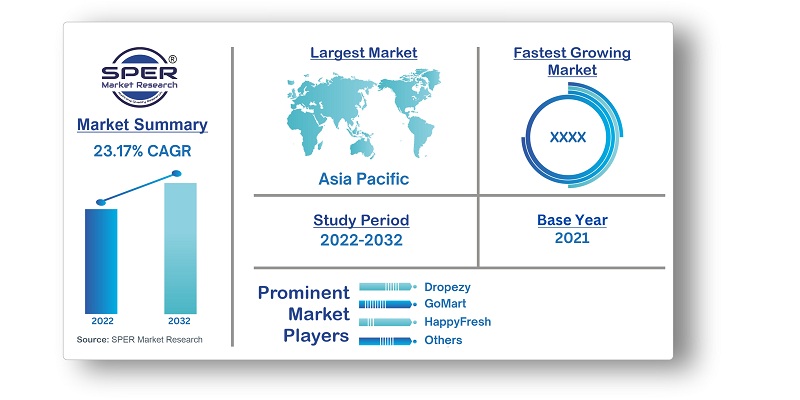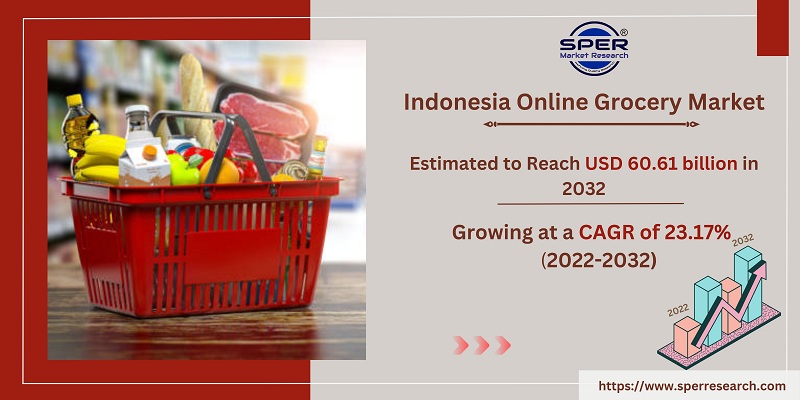
Indonesia Online Grocery Market Growth, Size, Trends, Revenue, Share, Scope and Future Outlook
Indonesia Online Grocery Market Size- By Product Category, By Age Group, By Gender, By Mode of Payment, By Mode of Delivery, By Type of Business- Regional Outlook, Competitive Strategies and Segment Forecast to 2032
| Published: Jan-2023 | Report ID: FMCG2302 | Pages: 1 - 107 | Formats*: |
| Category : Consumer & Retail | |||


| Report Metric | Details |
| Market size available for years | 2019-2032 |
| Base year considered | 2021 |
| Forecast period | 2022-2032 |
| Segments covered | By Product Category, By Age Group, By Gender, By Mode of Payment, By Mode of Delivery, By Type of Business |
| Regions covered | Java, Kalimantan, Lesser Sunda Islands, Sulawesi, Sumatra, Other Regions |
| Companies Covered | ChilliBeli, Dropezy, GoMart, GrabMart, HappyFresh, Sayurbox, Shopee, TaniHub, Tokopedia |
- Online Grocery Delivery Companies
- Supermarkets & Hypermarkets
- E-commerce Companies
- Food Delivery Companies
- Investors
- Beauty and Health
- Food & Beverages
- Fresh Food
- Household Supplies
- Others
- 18-24 years
- 25-37 years
- 38-44 years
- 45+ years
- Female
- Male
- Cash on Delivery
- Online Payment
- Express Delivery (30 Minutes to 120 Minutes)
- In a Specific Time Period (Same Day or Next Day)
- Other (2-3 Days or More)
- B2B
- B2C
- Java
- Kalimantan
- Lesser Sunda Islands
- Sulawesi
- Sumatra
- Other Regions
- Size of Indonesia Online Grocery Market (FY’2019-FY’2032)
- Overview of Indonesia Online Grocery Market
- Segmentation of Indonesia Online Grocery By Product Category (Beauty and Health, Food & Beverages, Fresh Food, Household Supplies, Others)
- Segmentation of Indonesia Online Grocery Market By Age Group (18-24 years, 25-37 years, 38-44 years, 45+ years)
- Segmentation of Indonesia Online Grocery Market By Gender (Female, Male)
- Segmentation of Indonesia Online Grocery Market By Mode of Payment (Cash on Delivery, Online Payment)
- Segmentation of Indonesia Online Grocery Market By Mode of Delivery {Express Delivery (30 Minutes to 120 Minutes), In a Specific Time Period (Same Day or Next Day), Other (2-3 Days or More)}
- Segmentation of Indonesia Online Grocery Market By Type of Business (B2B, B2C)
- Statistical Snap of Indonesia Online Grocery Market
- Growth Analysis of Indonesia Online Grocery Market
- Problems and Challenges in Indonesia Online Grocery Market
- Competitive Landscape in the Indonesia Online Grocery Market
- Impact of COVID-19 and Demonetization on Indonesia Online Grocery Market
- Details on Recent Investment in Indonesia Online Grocery Market
- Competitive Analysis of Indonesia Online Grocery Market
- Major Players in the Indonesia Online Grocery Market
- SWOT Analysis of Indonesia Online Grocery Market
- Indonesia Online Grocery Market Future Outlook and Projections (FY’2019-FY’2032)
- Recommendations from Analyst
1.1. Scope of the report1.2. Market segment analysis
2.1 Research data source
2.1.1 Secondary data2.1.2 Primary data2.1.3 SPER’s internal database2.1.4 Premium insight from KOL’s
2.2 Market size estimation
2.2.1 Top-down and Bottom-up approach
2.3 Data triangulation
4.1. Driver, Restraint, Opportunity and Challenges analysis
4.1.1 Drivers4.1.2 Restraints4.1.3 Opportunities4.1.4 Challenges
4.2. COVID-19 Impacts of the Indonesia Online Grocery Market
5.1. SWOT analysis
5.1.1 Strengths5.1.2 Weaknesses5.1.3 Opportunities5.1.4 Threats
5.2. PESTEL analysis
5.2.1 Political landscape5.2.2 Economic landscape5.2.3 Social landscape5.2.4 Technological landscape5.2.5 Environmental landscape5.2.6 Legal landscape
5.3. PORTER’S five forces analysis
5.3.1 Bargaining power of suppliers5.3.2 Bargaining power of Buyers5.3.3 Threat of Substitute5.3.4 Threat of new entrant5.3.5 Competitive rivalry
5.4. Heat map analysis
6.1 Indonesia Online Grocery Manufacturing Base Distribution, Sales Area, Product Type6.2 Mergers & Acquisitions, Partnerships, Product Launch, and Collaboration in Indonesia Online Grocery Market
7.1 Beauty and Health7.2 Food & Beverages7.3 Fresh Food7.4 Household Supplies7.5 Others
8.1 18-24 years8.2 25-37 years8.3 38-44 years8.4 45+ years
9.1 Female9.2 Male
10.1 Cash on Delivery10.2 Online Payment
11.1 Express Delivery (30 Minutes to 120 Minutes)11.2 In a Specific Time Period (Same Day or Next Day)11.3 Other (2-3 Days or More)
12.1 B2B12.2 B2C
13.1 Indonesia Online Grocery Size and Market Share by Region (2019-2025)13.2 Indonesia Online Grocery Size and Market Share by Region (2026-2032)13.3 Java13.4 Kalimantan13.5 Lesser Sunda Islands13.6 Sulawesi13.7 Sumatra13.8 Other Regions
14.1 ChilliBeli
14.1.1 Company details14.1.2 Financial outlook14.1.3 Product summary14.1.4 Recent developments
14.2 Dropezy
14.2.1 Company details14.2.2 Financial outlook14.2.3 Product summary14.2.4 Recent developments
14.3 GoMart
14.3.1 Company details14.3.2 Financial outlook14.3.3 Product summary14.3.4 Recent developments
14.4 GrabMart
14.4.1 Company details14.4.2 Financial outlook14.4.3 Product summary14.4.4 Recent developments
14.5 HappyFresh
14.5.1 Company details14.5.2 Financial outlook14.5.3 Product summary14.5.4 Recent developments
14.6 Sayurbox
14.6.1 Company details14.6.2 Financial outlook14.6.3 Product summary14.6.4 Recent developments
14.7 Shopee
14.7.1 Company details14.7.2 Financial outlook14.7.3 Product summary14.7.4 Recent developments
14.8 TaniHub
14.8.1 Company details14.8.2 Financial outlook14.8.3 Product summary14.8.4 Recent developments
14.9 Tokopedia
14.9.1 Company details14.9.2 Financial outlook14.9.3 Product summary14.9.4 Recent developments
SPER Market Research’s methodology uses great emphasis on primary research to ensure that the market intelligence insights are up to date, reliable and accurate. Primary interviews are done with players involved in each phase of a supply chain to analyze the market forecasting. The secondary research method is used to help you fully understand how the future markets and the spending patterns look likes.
The report is based on in-depth qualitative and quantitative analysis of the Product Market. The quantitative analysis involves the application of various projection and sampling techniques. The qualitative analysis involves primary interviews, surveys, and vendor briefings. The data gathered as a result of these processes are validated through experts opinion. Our research methodology entails an ideal mixture of primary and secondary initiatives.



Frequently Asked Questions About This Report
PLACE AN ORDER
Year End Discount
Sample Report
Pre-Purchase Inquiry
NEED CUSTOMIZATION?
Request CustomizationCALL OR EMAIL US
100% Secure Payment






Related Reports
Our Global Clients
Our data-driven insights have influenced the strategy of 200+ reputed companies across the globe.




















